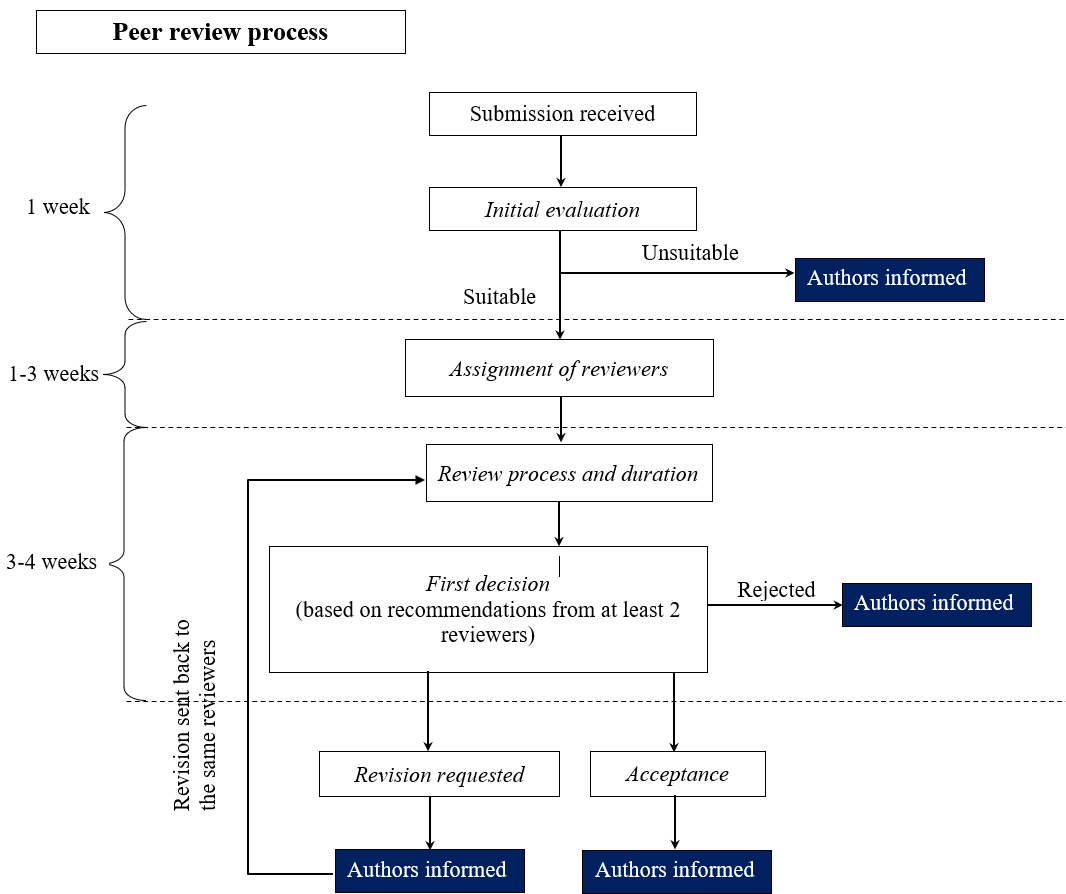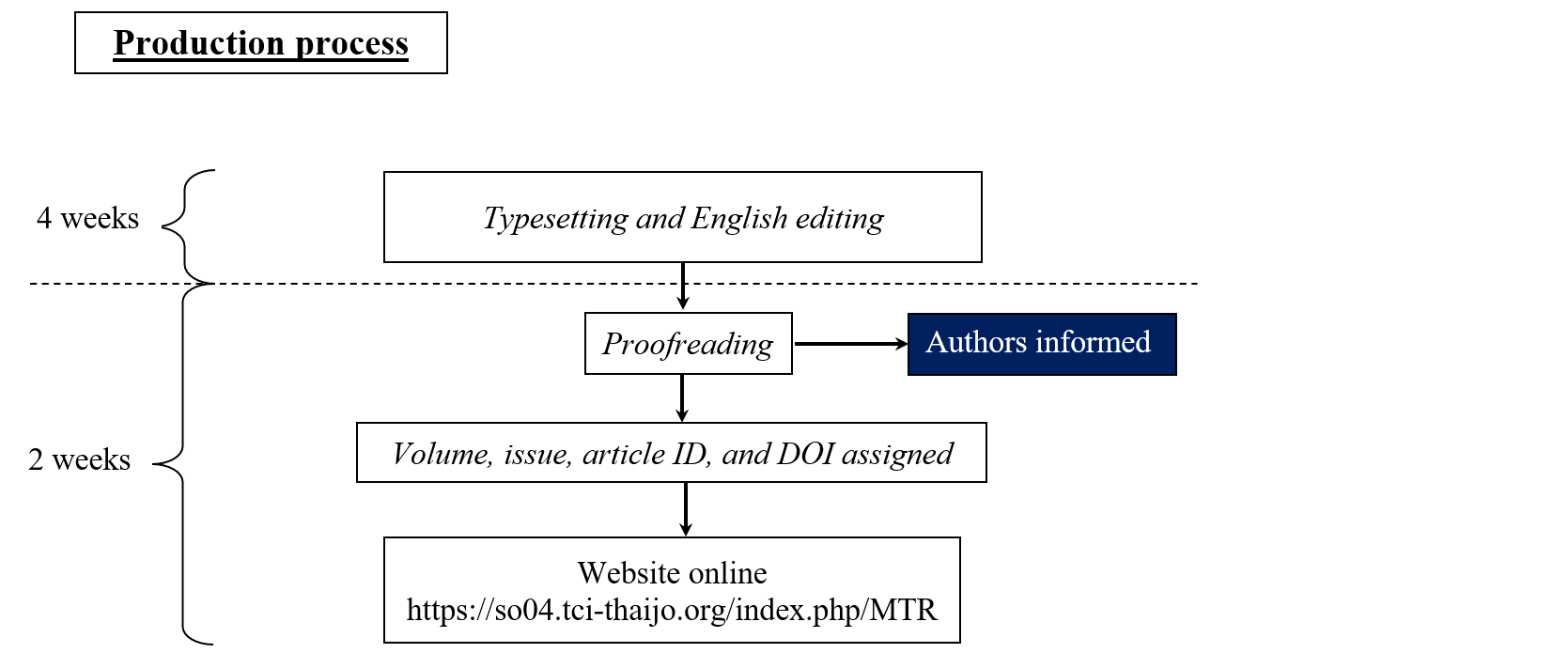Peer review and production processes

Peer review process
All submissions to MTR undergo a rigorous peer-review process to ensure the quality and validity of the published research. The review process is undertaken by experts in relevant fields of study, who evaluate the submitted manuscripts based on their scientific merit, originality, and relevance to the journal's scope. MTR implements a double-blinded review system with at least 2 expert reviewers. In this way, MTR can ensure that comments from the reviewers are academically sound and their recommendations are useful for authors.
Initial evaluation
After submission, MTR will screen for plagiarism by its internal system. If the plagiarism percentage is greater than 25 % (except the reference list), the submission will be rejected immediately. Later, the editor will read the abstract to check if the submission is appropriate for MTR. A screening of the article's structural components, quality of figures, and references will be done. If the overall quality is satisfactory, the submission will be sent to reviewers.
Assignment of reviewers
MTR implements a double-blinded review system with at least 2 expert reviewers. The editor will anonymize the submission by removing authors' names and affiliations, e-mail addresses, and acknowledgments. Then, the editor will start inviting reviewers. The invited reviewers are expected to be affiliated with different institutions from those of the corresponding author.
Review process and duration
Once the reviewers accept to review, it will take 3-4 weeks to complete the review. During the review process, the identity of authors is always unrevealed. The reviewers are expected to provide an unbiased, thorough review. If any of the invited reviewers return simple comments without any comments on the scientific content of the submission (such as "this is a good article", "please recheck typos", "please improve the figure quality", etc.), the editor may consider inviting additional reviewers.
First decision
The editor will make the first decision on whether to accept, reject, or request a revision of the manuscript based on the feedback provided by the reviewers and the manuscript's adherence to the publication conditions. If the comments and recommendations from the reviewers differ significantly, the editor may invite an additional reviewer before making the first decision. In case there are more than 2 reviewers and one reviewer declines the submission, the editor may choose to request a revision based on the opinions of the majority of reviewers.
The editor will send a decision (with rejection, acceptance, or the need for major or minor revisions) to the authors via the online system, along with any relevant comments submitted by the reviewers. All comments and suggestions will remain anonymous.
Revision requested
Normally, the authors are given 4 weeks to revise their manuscript. If the authors decide to revise and submit their revision, the editor will primarily investigate whether the authors address comments from every reviewer. In a case where the authors do not address the comments from every reviewer, the editor will contact the authors and request them to complete their responses.
If a reviewer previously recommends "resubmit for review", the revised manuscript will be sent back to the same reviewer for re-evaluation. If a reviewer previously recommends "revision", the editor will perform a thorough check on how the authors address all reviewers' comments, and decide whether or not the revision should be sent to the same reviewers for re-assessment. At this stage, if the editor considers the authors' responses to be satisfactory, the editor can accept the revision and proceed with the publication without sending the revised manuscript to the same reviewers.
For a submission that has been reviewed by more than 2 reviewers, and one of the reviewers has declined a submission during the first round of review, the editor may choose not to invite the reviewer who rejected the initial submission to review the revision. The editor may proceed with 2 reviewers who request a revision.
If sent to the same reviewers, the revision will again undergo a double-blind review process. The same reviewers will be given 4 weeks to complete their re-review. A second or third revision is possible if the reviewers are not satisfied or still have academically critical comments. There may be a case when even a revision is rejected because the authors do not seriously consider the reviewers' comments and address them critically.
After a revision is reviewed, if one reviewer accepts the revision but another reviewer declines it or demands further improvement, the editor will consider whether to request another revision, or to invite a new reviewer for an additional recommendation. If the majority of the reviewers accept the revision, the editor will use unbiased judgment to decide whether to accept or request another revision.
Additionally, after a first revision is reviewed, if one reviewer accepts the first revision but another reviewer requests further improvement, the editor will consider whether such a request is major or minor. If it is considered minor by the editor, the second revision will be carefully checked by the editor whether the authors have responded satisfactorily to the remaining comments. Using an unbiased judgment, the editor may proceed without sending the second revision to the remaining reviewer.
In a case where there are 2 reviewers accepting to review the revision and one of those reviewers is not reachable after a review due date has passed, the editor will send a reminder to the remaining reviewer. Within 7 days after sending the reminder, if the remaining reviewer is still not reachable and another reviewer accepts the revision without further comment, the editor will investigate how the authors respond to the comments of the uncontactable reviewer. The editor will use unbiased judgment to check if the authors satisfactorily respond to the comments, and may proceed with the acceptance.
Moreover, if the editor sends a review request to the same reviewers who reviewed the initial submission but they (or one of them) do not respond to the revision review invitation, the editor will send two reminders to the unreachable reviewer(s). The first reminder will be sent after the response due date has passed. The second reminder will be sent 7 days after the first reminder. Within 7 days after sending the second reminder, if the same reviewers are still uncontactable, the editor will look at how the authors respond to the comments previously raised by the reviewers. Using unbiased judgment, the editor may accept the revision if the comments are addressed satisfactorily, and those addressed points are considered minor. On the other hand, the editor may request another revision if the authors ignore some comments or respond poorly to any of those observations. An invitation may be sent to a new reviewer if the editor wants to seek additional opinions.
Acceptance
Once the manuscript has been accepted for publication, the authors will be informed. This double-blind peer review process will ensure that all manuscripts submitted to MTR are evaluated based on the highest standards of scientific integrity and ethical conduct.

Production process
After the manuscript is accepted for publication in MTR, the production process will be undertaken.
Typesetting and English editing
The editorial office will begin to typeset the accepted manuscript. The copy-edited article will be sent to a native English editor for grammatical checking. The typesetting and the English editing will take approximately 4 weeks.
Proofreading
The authors will then be contacted for proofreading and answering all queries raised by the language editor. The authors will be asked to improve figures with low quality. A copyright transfer form will be sent to the corresponding author to sign on behalf of all co-authors. If the corresponding author does not return the signed copyright transfer form to MTR, the article will not be taken to the next production stage.
Volume, issue, article ID, and DOI assigned
The article will be published online immediately after all processes are completed. Volume, issue, and article ID will be given. A DOI will always be assigned to the published article.







